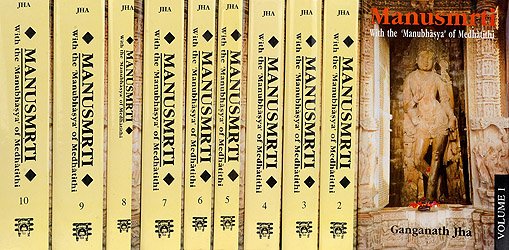Manusmriti with the Commentary of Medhatithi
by Ganganatha Jha | 1920 | 1,381,940 words | ISBN-10: 8120811550 | ISBN-13: 9788120811553
This is the English translation of the Manusmriti, which is a collection of Sanskrit verses dealing with ‘Dharma’, a collective name for human purpose, their duties and the law. Various topics will be dealt with, but this volume of the series includes 12 discourses (adhyaya). The commentary on this text by Medhatithi elaborately explains various t...
Verse 5.37
Sanskrit text, Unicode transliteration and English translation by Ganganath Jha:
कुर्याद् घृतपशुं सङ्गे कुर्यात् पिष्टपशुं तथा ।
न त्वेव तु वृथा हन्तुं पशुमिच्छेत् कदा चन ॥ ३७ ॥kuryād ghṛtapaśuṃ saṅge kuryāt piṣṭapaśuṃ tathā |
na tveva tu vṛthā hantuṃ paśumicchet kadā cana || 37 ||If there is occasion, he shall make an animal of clarified butter, or an animal of flour; but he shall never seek to kill an animal needlessly.—(37)
Medhātithi’s commentary (manubhāṣya):
People are likely to entertain such ideas as the following—“at the Sītā - yajña the Khañjikā-yāga, the Caṇḍikā-yāga and the like, which are performed on the authority of usage only, it is right for the man desiring a certain result to kill animals; for it has been found that one obtains a rich harvest by offering sacrifices at which animals are killed.”
With a view to set aside such notions the text says—‘It there is occasion,’—if necessity arises for the offering of an animal in sacrifice,—‘he shall make an animal of clarified butter’; i.e., he shall make clarified butter the sacrificial animal: that is, it being necessary to otter an animal to the Gods, he shall offer, in its place, clarified butter: which is as good a ‘sacrificial material’.
‘Or, he shall make an animal of flour’; i.e. he shall make the figure of an animal with flour, and offer that figure to the Gods; or, it may be taken to mean that ‘instead of the animal he shall offer cakes and other things made of flour’.
“Why is this called needless animal-slaughter, when it is sanctioned by the usage of cultured people?”
Since women, and Śūdras are ignorant of the Veda, such sacrifices as those mentioned cannot be assumed to have any sanction in the Veda: specially as people have reconrse (recourse?) to these sacrifices for the purpose of propitiating the Gods, and no Vedic act is done for the propitiating of Gods; for the simple reason that in connection with Vedic rites, Gods have been mentioned as subordinate factors. In fact, what they urge in support of the performance of the sacrifices in question is the argument based upon negative and positive induction, from the experience that there is rich harvest when Gods are propitiated with the sacrifice of animals. For these reasons, these sacrifices cannot be regarded as having the sanction of the Veda. As for the positive and negative induction that also is entirely mistaken.
From all this it is clear that the present verse only reiterates what is already indicated as the right course by al (all?) kinds of reasons: and it has been put forward by the author through feelings of friendly kindliness.—(37)
Explanatory notes by Ganganath Jha
‘Saṅge’—‘On an occasion arising for the killing of an animal (at a rite other than those laid down in the Veda)’ (Medhātithi);—‘if one has a strong desire to eat meat’ (Kullūka and Nārāyanā). [It is difficult to see how a strong desire for meat could be appeased by eating animal made of butter or flour];—‘in the event of one being attacked by evil spirits’ (Govindarāja);—‘on the occasion of social gatherings’ (Nandana).
This verse is quoted in Vīramitrodaya (Āhnika, p. 538), which quotes Kalpataru as offering the following explanation:—In such ceremonies as the Sītāyajña and the like, which are not prescribed in the Veda, and the killing of animals at which, therefore, cannot have the sanction of the Veda,—if, in view of the prevalent custom, it is found necessary to sacrifice an animal, one should offer an animal made either of butter or of flour;—it then quotes Kullūka’s explanation,—and then the one given by Medhātithi, remarking that this last is in agreement with Kalpataru,—It then goes on to describe another explanation, by which ‘Saṅge’ means ‘at a sacrifice’ and this is explained as laying down an alternative to the killing of animals at the well-known sacrifices, Agnīṣṭomīya and the rest.—This last explanation, the author rejects, on the ground (1) that there is no authority for taking the word ‘saṅge’ in the sense of sacrifice, and (2) that it would not be right for a Smṛti to lay down an alternative to a detail that has been laid down in the original Vedic injunction of the sacrifices.
